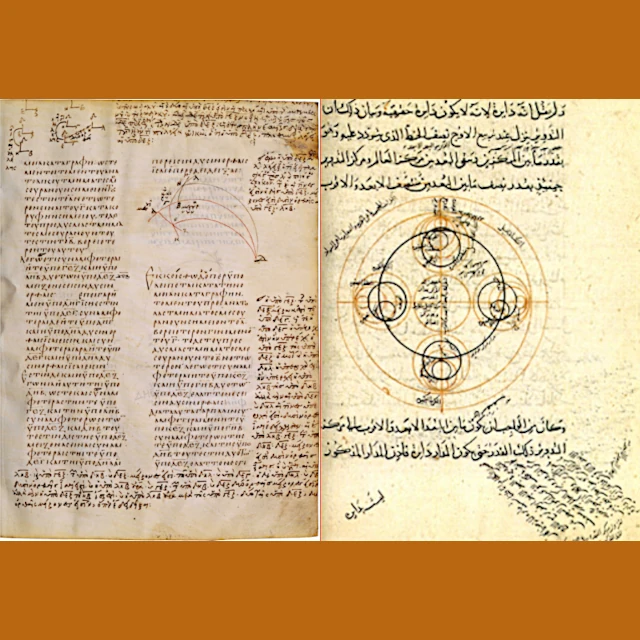
Written around 150 CE by Claudius Ptolemy (100-170), the Almagest is a monumental work in the history of celestial observation, based on rigorous mathematical formalism. The book consolidates earlier observations from the Greek tradition and introduces structured geometric models to describe celestial movements.
The word Almagest comes from the Arabic "al-Majisti," itself derived from the Greek "Megistē," meaning "the very great" or "the greatest." It was a way to designate Ptolemy's work as the greatest astronomical treatise of its time.
This monumental work was structured into 13 books (intellectual division, not necessarily physical), probably initially recorded on papyrus scrolls in the format used in the 2nd century CE in the Roman Empire.
Nearly two millennia after its writing, Ptolemy's Almagest occupies a paradoxical place in the history of science. Its geocentric model has been definitively refuted, yet the work remains an essential reference. So, what actually remains of this scientific monument from Antiquity?
The most enduring contribution of the Almagest lies in its rigorous scientific approach. Ptolemy established a research model that combines systematic observation, mathematical modeling, and verification through calculation. This hypothetico-deductive approach, which involves proposing a model and then confronting it with observed data, remains at the heart of the modern scientific method.
The Almagest contains sophisticated trigonometric techniques that have retained their validity. The chord tables developed by Ptolemy, ancestors of our trigonometric tables, allowed solving complex geometric problems. The interpolation methods and angle calculations he developed are still taught in their fundamental principles.
The catalog of 1022 stars included in the Almagest is an irreplaceable astronomical testimony. Although some positions have been contested, this data allows astronomical historians to study the evolution of stellar positions and offers a unique insight into the observational knowledge of Antiquity.
Beyond pure science, the Almagest shaped Western and Arab thought for nearly fifteen centuries. It structured the teaching of astronomy, influenced natural philosophy, and provided the basis for the calendar and navigation. This historical and cultural dimension makes the work a major intellectual heritage of humanity.
Paradoxically, it is in its "conceptual error" regarding the theory of epicycles and deferents that the Almagest remains most instructive. To maintain geocentrism in the face of increasingly precise observations, Ptolemy (and his successors) had to add additional epicycles, eccentrics, and equants, making the system increasingly complicated.
This demonstrates that a scientific model can be mathematically coherent, predictive, and useful while being based on incorrect postulates. This epistemological lesson reminds us that science progresses through successive approximations and that scientific "truth" is always provisional and improvable.
| Concept | Almagest (2nd century CE) | Modern Astronomy (21st century) | Status |
|---|---|---|---|
| Earth's Position | Earth immobile at the center of the universe | Planets orbiting the Sun | Refuted (geocentrism abandoned) |
| Planetary Movements | Epicycles, deferents, and equant | Elliptical orbits (Kepler's laws) | Refuted (epicycle/deferent model replaced by elliptical orbits), but mathematical method preserved |
| Celestial Coordinates | Ecliptic longitudes and latitudes on the celestial sphere (star catalog) | Still used today, but with different coordinate systems (right ascension and declination) | Kept and improved (modernized coordinate systems) |
| Methodological Approach | Mathematical adjustment to fit observations, without seeking to discover physical causes (descriptive model) | Scientific method based on testable prediction and falsifiability (explanatory model) | Kept with nuance, modern science relies on the scientific method: Observation → hypothesis → prediction → test → falsification |
| Precession of the Equinoxes | Recognized influence but underestimated value (≈ 1° / century) | Precisely measured movement (≈ 1° / 71.6 years) | Kept (concept preserved, value corrected) |
| Solar and Lunar Eclipses | Approximate predictions from tables and cycles (Saros, etc.) | Precise predictions thanks to celestial mechanics and gravitation | Kept (principle preserved, precision improved) |
| Star Catalog and Magnitudes | 1022 stars classified according to their apparent magnitude | Modern photometric systems (UBV, Gaia) | Kept and improved (systematic catalog preserved, precision modernized) |
| Calendar Cycles and Tropical Year | Approximate duration of the tropical year (365.2467 days) and calculation of equinoxes | Precise duration of the tropical year (365.2422 days) and modern astronomical calendar | Kept (principle preserved, values corrected) |
N.B.:
The precession of the equinoxes, discovered by Hipparchus, is integrated into the Almagest. Ptolemy adopts the principle but underestimates its speed by about 30%. The modern established value is 1° every 71.6 years, due to the slow rotation of the Earth's axis.
References:
Verbunt & van Gent (2012); Protte & Hoffmann (2020); Schaefer (2013); ENS Lyon (precession); BnF (star catalog); IREM Caen (Almagest plan).